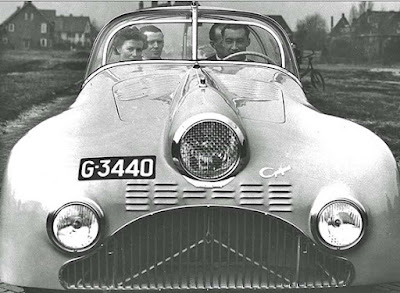Defying Odds - For those who find beauty in rare machines and stories of fearless ingenuity, few tales are as captivating as the legacy left by
Maurice 'Maus' Gatsonides. Not long ago, we explored one of his standout creations—
the 1948 Gatso 4000 Aero, a sleek and ambitious sports car that reflected his unique approach to automotive design. But behind every great machine is a greater story, and
Gatsonides had more than one ace up his sleeve. One of them was the
Gatso 1500 'Platje', a spirited little roadster affectionately nicknamed by fans and admired for both its charm and unexpected performance.
 |
| The Gatso 1500 'Platje' was a spirited little roadster, built by Maus Gatsonides on a modified Fiat 1500 chassis, admired for its charm and surprising performance. (Picture from: WorldCarsFromThe1930sTo1980s in Facebook) |
Gatsonides,
a Dutchman with a relentless passion for motorsport,
wasn’t content with just being behind the wheel.
Long before his name became associated with the invention of the speed camera,
he was making headlines as a rally driver. He competed in
the Monte Carlo Rally over twenty times,
even winning it in 1953 with
a Ford Zephyr. But racing wasn't just a pastime—it was his laboratory. Every turn, every finish line, fed into his dream of building the perfect sports car under his own brand,
Gatso, which he officially launched in
1948.
 |
| Maus Gatsonides at the wheel of the Gatso Aero Coupé, accompanied by his wife Siska and two colleagues in the back. (Picture from: VeloceToday) |
While some of his early builds borrowed powerful components from
Ford—including
Mercury’s robust V8 engines—one particular project took a different route.
Built on a modified chassis from the Fiat 1500,
Gatsonides designed a lightweight, minimalist racing roadster aimed at dominating its class. At its core was
a 1.5-liter inline-six engine producing a modest 47 horsepower. It might not sound like much on paper, but in practice, it was something else entirely.
 |
| The last Gatso, a low-slung roadster nicknamed “Platje,” used a Fiat 1500 chassis and engine, seen racing by Gatsonides at Zandvoort in 1949. (Picture from: VeloceToday) |
The car made its racing debut on the iconic circuit of Zandvoort,
and it didn’t just show up—
it stole the spotlight. It outpaced a field of
respected MGs and
set a record lap time in its engine class,
clocking an average speed of 102.5 km/h.
The crowd took notice—
not just of its performance,
but of its strikingly low,
flat profile.
Inspired by its looks and perhaps charmed by its underdog spirit,
spectators nicknamed it “Platje,” a Dutch term meaning something like “little flat one.” |
| The Gatso 1500 'Platje' was designed by Maus Gatsonides as a lightweight, minimalist racing roadster, built to dominate its class with a strikingly low, flat profile. (Picture from: Autogen.pl) |
For
Gatsonides, it was a moment of validation. The
Platje was proof that his vision, no matter how unconventional, had the power to stir real excitement. Sadly, excitement alone couldn’t keep a small manufacturer afloat. The attempt to put
Gatso cars into broader production met financial headwinds.
Only a few units were sold,
and with mounting debts,
Gatsonides was forced to shut down operations. The
Platje, once a symbol of promise, faded into obscurity.
 |
| The Gatso 1500 'Platje' features a stripped-down, purpose-built cockpit that reflects its racing spirit—exposed metal flooring, a clean dashboard lined with essential gauges, and a no-frills four-spoke steering wheel all emphasize its minimalist, driver-focused design philosophy. (Picture from: WorldCarsFromThe1930sTo1980s in Facebook) |
But good stories don’t end that easily.
After spending decades forgotten in a shed,
the car resurfaced near the turn of the century and was lovingly restored by Joop Bruggeman. Today, it stands not only as a rare piece of automotive history but also as a tribute to one man’s relentless pursuit of speed and style.
 |
| The Gatso 1500 'Platje' was powered by a 1.5-liter inline-six engine of Fiat origin, delivering a modest 47 horsepower that proved surprisingly capable on the track. (Picture from: WorldCarsFromThe1930sTo1980s in Facebook) |
Note: This blog can be accessed via your smart phone.






 Maus Gatsonides passed away in 1998 at the age of 88, but his creations—especially the Gatso 1500 Platje—continue to capture the imagination of those who appreciate the beauty of bold ideas, however fleeting they may be. Because sometimes, the greatest stories come from the smallest cars. *** [EKA | FROM VARIOUS SOURCES | AUTOGEN.PL | WIKIPEDIA | THESAHB | AUTA5P.EU | VELOCETODAY | WORLD CARS FROM THE 1930S TO 1980S IN FACEBOOK ]
Maus Gatsonides passed away in 1998 at the age of 88, but his creations—especially the Gatso 1500 Platje—continue to capture the imagination of those who appreciate the beauty of bold ideas, however fleeting they may be. Because sometimes, the greatest stories come from the smallest cars. *** [EKA | FROM VARIOUS SOURCES | AUTOGEN.PL | WIKIPEDIA | THESAHB | AUTA5P.EU | VELOCETODAY | WORLD CARS FROM THE 1930S TO 1980S IN FACEBOOK ]
